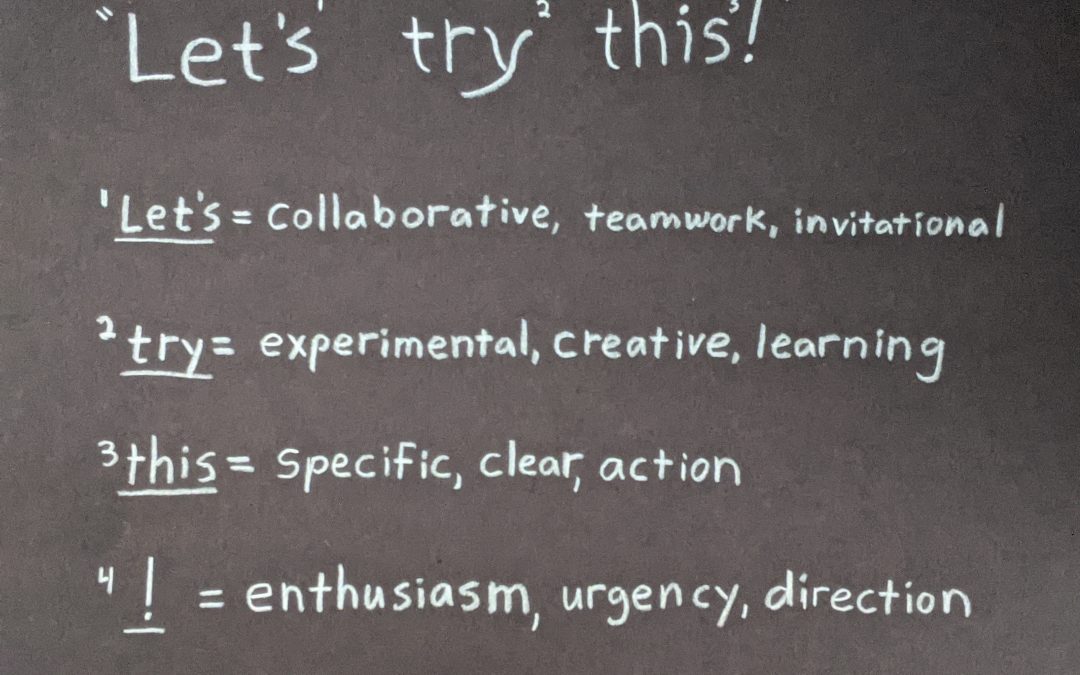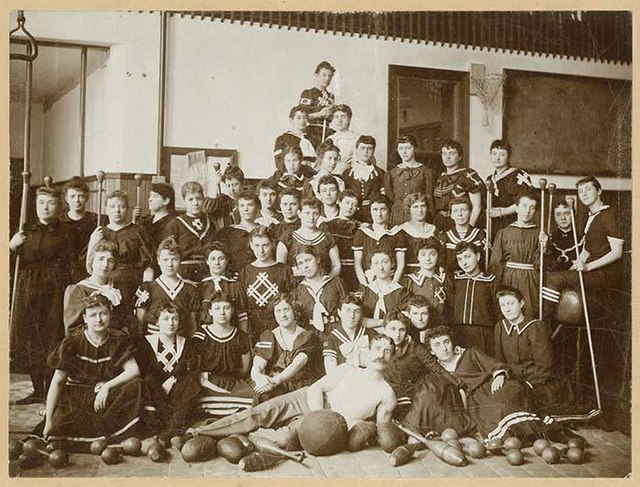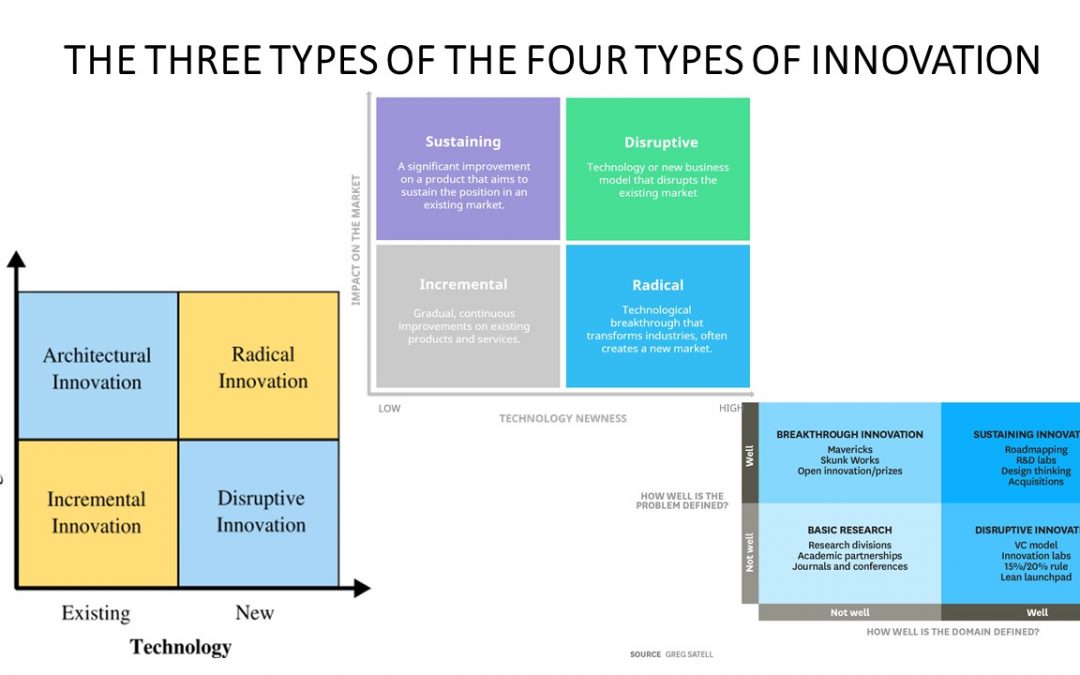
by dbward | Feb 7, 2022 | Innovation Coaching
When we’re trying to make change in an organization, starting a new initiative, and generally learning & growing as a professional, my favorite phrase to use is “Let’s Try This!”
If we say it correctly, it’s an inclusive invitation to experiment and learn something specific. Say it more than once and we’re on our way to an iterative series of collaborative experiments.
Please note that pronunciation matters. It’s not pronounced “Let’s ONLY try this” or “You have to try this” or “This will definitely work.” If we use these three words it in an exclusive or controlling way, if it’s directed at YOU instead of US, or if there’s an implication of certainty and predictability, we’re saying it wrong.
And of course, it’s not enough to just say it, we also need to be ready to hear it from our teammates and respond accordingly. And if we really want to crank it up to 11, let’s sprinkle some “Yes-And” pixie dust on it too.
It’s the closest thing to a magic formula I know. I hope you’ll join me in giving it a try (see what I did there?). And remember, it’s pronounced leviOsa, not levioSA.

by dbward | Jan 31, 2022 | celebrating failure |
The book was titled Perfect Vegetables, so imagine my surprise when I opened it to a random page and came across this line:
“None of the methods proved satisfactory. The wrapped leeks were too tough and dry, while the naked ones were too tough to chew.”
I was struck by this blunt description of their failure, and even more struck when I realized this pattern was consistent throughout the whole book, from artichokes to zucchini. Page after page provided detailed descriptions of disappointing results, cooking techniques that didn’t work, and veggies that were bland, limp, or otherwise inedible… the opposite of perfect. I realized that this book was not just “350 exhaustively tested recipes” (as the cover says), it’s also the failure-filled story behind each one.
I love everything about this. If ITK made a cookbook, I bet it would look a lot like Perfect Vegetables.
Whether the subject is a Master Recipe for Grilled Fennel (page 122) or helping a team build clarity and consensus around their problem statement, the path to perfection is paved with lots of imperfect attempts, lots of little experiments that generate insights… if we’re paying close enough attention.
It’s easy to overlook that fact if all we see is the final, finished, perfect product. By sharing their process and describing all the dead-ends they explored, the authors help readers really understand the deeper practice of cooking well. None of these “perfect” recipes came out of thin air. In some cases, the air was full of the smoky residue of burned peppers (pg 184).
So don’t worry if some of your ITK experiments don’t quite turn out the way you’d hoped. That’s all part of the process, and we’ve all been there. When that happens, just do what Team Toolkit does – toss those veggies in the trash and start baking a Failure Cake.

by dbward | Jan 24, 2022 | Tutorials, Uncategorized
Writing is HARD.
I think that one of the reasons that writing is hard is that it requires clarity of thought. It requires a purpose. And the blank page can imply a lack of both.
Writing also requires a certain level of technical skill, in order to avoid using awkward phrases like “I think that one of the reasons that writing is hard is that…” Yikes. That’s some bad writing right there.
HOWEVER… the secret to good writing is to first write badly. Good writing is just bad writing, rewritten. And so, good writers allow themselves to write bad first drafts, turning off their inner editor and letting the words flow, however messily.
One might even perform an exercise such as the following:
“These words I am currently writing are the wrong words. I am writing them but they are not exactly what I want to say. This is ok. I will delete these words later, because they do not make my point, do not advance the narrative, do not add clarity or value to the overall piece, and some of them are probbabbly misssplled. They do, however, help me build momentum and they give me something to work with, even if the only work to be done is the work of deletion. I will now delete this previous paragraph, because what I really want to say is…”
So… maybe writing is EASY.
Just put ink on paper.
Edit later.
Think later.
Yeah, I like that.
Ink now, think later.
Maybe that makes sense.
Maybe it’s true.
Maybe it’s good advice?
I don’t know yet, but I might know tomorrow, when I come back to this page and read it with tomorrow’s eyes, a fresh eraser, and a sharpened pencil.
What does this have to do with ITK? A lot, actually, because communication is a key aspect of innovation. The best ideas in the world are worthless if we can’t express them clearly, so developing our ability to write is an important component of our ability to innovate.

by dbward | Jan 18, 2022 | Uncategorized
The funny thing about the Innovation Toolkit is… it’s not really about innovation.
Or more specifically, it’s not just about innovation. Most of our focus is actually on helping teams work together to solve hard problems. The fact that this approach to collaborative problem-solving tends to produce results that are novel and impactful (i.e. innovative) is sot of an added bonus. But the whole “working well together” thing is the main point.
Then again, the ITK movement is all about new ways of working together, bringing new groups together in new and interesting ways. We help teams function more effectively by being more collaborative, by asking better questions, and embracing more diversity. We introduce new tools and new techniques that help to unlock new levels of creativity.
So… maybe that’s what’s so innovative about ITK. Maybe the real innovation is the friends we made along the way.

by dbward | Jan 10, 2022 | Innovation Coaching
I often point out that innovation is one of those words that gets USED more often than it gets DEFINED. That is true, but it’s also true that innovation gets defined ALL THE DANG TIME, and in lots of interesting and amusing ways.
For example, ask your favorite search engine to show you “types of innovation,” and you’ll be treated to a bewildering collection of frameworks, infographics, and diagrams, many of which claim to show THE different types of innovation. The image above shows three types of the four types of innovation, while the image below shows several different ways to arrange the 10 (9?) types of innovation.

It’s ok to have a little laugh about all this. This situation is indeed kinda funny, and can also be a little confusing. Here’s the good news – this situation is also informative and educational if we approach it the right way.
Instead of getting too attached to any particular representation of THE types of innovation, we might adopt a curious posture towards all of them. We may find that each framework illuminates some facet of innovation… and casts a shadow on other facets. We may discover that while each one provides some insight on the topic, each framework also introduces gaps that leaves important aspects unaddressed. Thus, we may benefit by becoming familiar with a whole bunch of them. And when we do that, we might even develop our own framework, our own contribution to the discussion.
As Seth Godin often points out, one hallmark of a professional – in any field – is that he or she does the reading, and is familiar with the latest developments and thinking in their field. So please consider this your personal invitation to do the reading this year. If you want to be a professional in a field that values innovation, you should be able to define innovation and not only discuss the different types, but also the different taxonomies – why and how they differ, the strengths and weaknesses and applications of each.






